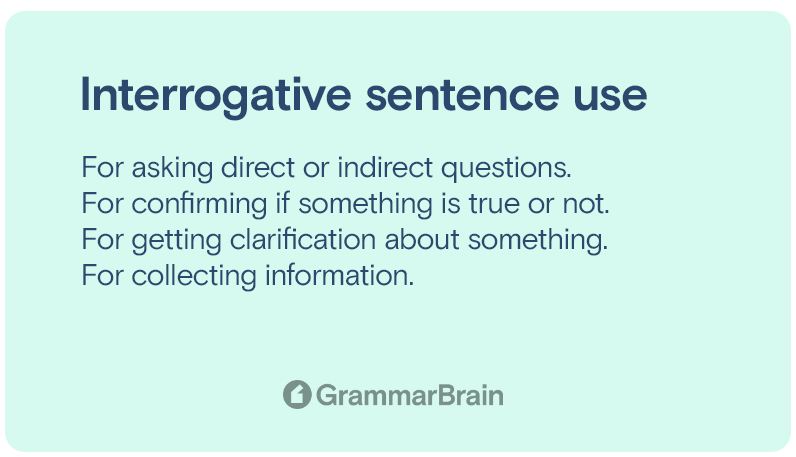What is an interrogative sentence? Typically a sentence conveys statements, instructions, questions, or emotions. A sentence that asks questions is called an interrogative sentence. In other words, an interrogative sentence is a sentence that gathers information regarding something. It usually starts with an interrogative pronoun like which, who, or what, and ends with a question mark. It also begins with an auxiliary verb or a modal verb and ends with a question mark.
Examples:
- Where do you live?
- Where is India located on the map?
- Do you eat meat? (Starts with an auxiliary verb “do”)
- Would you help me with washing the dishes? (Starts with a modal verb “would”)
How to structure an interrogative sentence?
The interrogative sentence is structured in the following manner:
If constructing the sentence with an auxiliary verb, the structure is “Auxiliary verb + Subject + Verb + Other words”.
On the other hand, when constructing the sentence with interrogative pronouns, the structure is “Interrogative Pronouns (Where, What, Who, Whom, etc.) + Auxiliary Verb + Subject + Main Verb + Other Words”.
| Sentence structure | Rule |
| Sentence with auxiliary verb | Auxiliary verb + Subject + Verb + Other words |
| Interrogative pronoun sentence | Interrogative Pronouns (Where, What, Who, Whom, etc.) + Auxiliary Verb + Subject + Main Verb + Other Words |

What are the different types of interrogative sentences?
Interrogative sentences are divided into four types. These are:
- Interrogative Pronoun Questions
- Yes Or No Questions
- Choice Question or Alternative Question
- Tag Questions
Here is a detailed explanation of each one of them with examples.
Interrogative pronoun questions
These questions start with “Wh” words like what, which, where, why, whom, and who. Here is the structure to form interrogative pronoun questions.
Structure: Interrogative Pronoun + Auxiliary Verb + Subject + Main Verb + Other Words.
Examples:
- What is John doing in the kitchen?
- Where is Amelie going?
- Where did the bus stop?
- Why was Shawn sitting alone in the classroom?
- Who is James dancing with?
Yes or No questions
This type of interrogative sentence asks a question whose answer is yes or no. Here is the structure for forming yes or no questions.
Structure: Auxiliary verb + Subject + Verb + Other Words.
Examples:
- Can fish survive on land? Here, the answer is No.
- Does a tiger eat meat? Here, the answer is Yes.
- Do goats eat meat? Here, the answer is No.
- Has she returned from school? Here, the answer could be either Yes or No.
- Was he attending school at 2 P.M. yesterday? Here, the answer could be either Yes or No.
Choice questions
These types of questions are used to ask about a person’s likes, dislikes, or interests. These questions give a couple or more choices for the listener to pick from. Here is the structure for constructing choice questions.
Structure: Auxiliary Verb + Subject + Verb + Choice One Or Two + Other Words.
Examples:
- Do you like Football or Cricket?
- Will you have sandwiches or cereal for breakfast?
- Is James visiting New York or London?
- Do you want to take the bus or train to visit the village?
- Does he want a blue or black dress for the wedding?
- Did Amy walk or jog in the morning?
- Is he standing for presidential elections or prime ministerial elections?
- Does she live in New York or San Francisco?

Tag questions
A tag question is a statement where at the end of the statement a question is asked. It is used in confirming if a piece of information is correct or wrong. Here is the typical structure of tag questions.
Structure: Subject + Auxiliary verb + Main Verb, Auxiliary Verb + Subject.
As it is segregated into two segments, if the first segment is a positive statement, then the second segment consists of a negative question tag. On the other hand, if the first segment is a negative statement, then the second segment consists of a positive tag. Here are a few examples to explain them.
Examples:
- You are eating lunch, aren’t you? Here, the first segment in the sentence is a positive statement, and the second segment has a negative tag.
- John has finished his homework, hasn’t he?
- Fishes have fins, don’t they?
- It was raining yesterday, wasn’t it?
- They were playing in the snow, weren’t they?
- They will not travel to Sydney from Melbourne by car, will they? Here the first segment is a negative statement. The second segment of the sentence is a positive question tag.
- We have not received the cash, have we?
- She is not singing for the concert, is she?
- I can not enter her home without removing my shoes, can I?
- She is not putting effort into her studies, is she?
FAQs
Can interrogative negative sentences be formed?
Forming negative interrogative sentences is possible. Here are a few examples of negative interrogative sentences.
Examples:
- Why don’t you like eating vegetables?
- Don’t you like drinking tea?
- Why didn’t you practice Yoga yesterday?
- Why don’t you like playing with your brother?
What are the different types of sentences?
In English grammar, there are four types of sentences. These are:
- Declarative Sentence – Sentences that express statements.
- Imperative Sentence – Sentences that give commands.
- Interrogative Sentence – Sentences that ask questions.
- Exclamatory Sentence – Sentences that express emotions.
What are some uses of an interrogative sentence?
Interrogative sentences are used:
- For asking direct or indirect questions.
- For confirming if something is true or not.
- For getting clarification about something.
- For collecting information.
Sources
- Interrogative Sentence – Uses, Types, and Examples
- Tag Questions | Grammar | EnglishClub
- Tag Questions
- Interrogative Sentence: Types and Examples
Inside this article
Fact checked:
Content is rigorously reviewed by a team of qualified and experienced fact checkers. Fact checkers review articles for factual accuracy, relevance, and timeliness. Learn more.
Core lessons
Glossary
- Abstract Noun
- Accusative Case
- Anecdote
- Antonym
- Active Sentence
- Adverb
- Adjective
- Allegory
- Alliteration
- Adjective Clause
- Adjective Phrase
- Ampersand
- Anastrophe
- Adverbial Clause
- Appositive Phrase
- Clause
- Compound Adjective
- Complex Sentence
- Compound Words
- Compound Predicate
- Common Noun
- Comparative Adjective
- Comparative and Superlative
- Compound Noun
- Compound Subject
- Compound Sentence
- Copular Verb
- Collective Noun
- Colloquialism
- Conciseness
- Consonance
- Conditional
- Concrete Noun
- Conjunction
- Conjugation
- Conditional Sentence
- Comma Splice
- Correlative Conjunction
- Coordinating Conjunction
- Coordinate Adjective
- Cumulative Adjective
- Dative Case
- Determiner
- Declarative Sentence
- Declarative Statement
- Direct Object Pronoun
- Direct Object
- Diction
- Diphthong
- Dangling Modifier
- Demonstrative Pronoun
- Demonstrative Adjective
- Direct Characterization
- Definite Article
- Doublespeak
- False Dilemma Fallacy
- Future Perfect Progressive
- Future Simple
- Future Perfect Continuous
- Future Perfect
- First Conditional
- Irregular Adjective
- Irregular Verb
- Imperative Sentence
- Indefinite Article
- Intransitive Verb
- Introductory Phrase
- Indefinite Pronoun
- Indirect Characterization
- Interrogative Sentence
- Intensive Pronoun
- Inanimate Object
- Indefinite Tense
- Infinitive Phrase
- Interjection
- Intensifier
- Infinitive
- Indicative Mood
- Participle
- Parallelism
- Prepositional Phrase
- Past Simple Tense
- Past Continuous Tense
- Past Perfect Tense
- Past Progressive Tense
- Present Simple Tense
- Present Perfect Tense
- Personal Pronoun
- Personification
- Persuasive Writing
- Parallel Structure
- Phrasal Verb
- Predicate Adjective
- Predicate Nominative
- Phonetic Language
- Plural Noun
- Punctuation
- Punctuation Marks
- Preposition
- Preposition of Place
- Parts of Speech
- Possessive Adjective
- Possessive Determiner
- Possessive Case
- Possessive Noun
- Proper Adjective
- Proper Noun
- Present Participle
- Prefix
- Predicate



